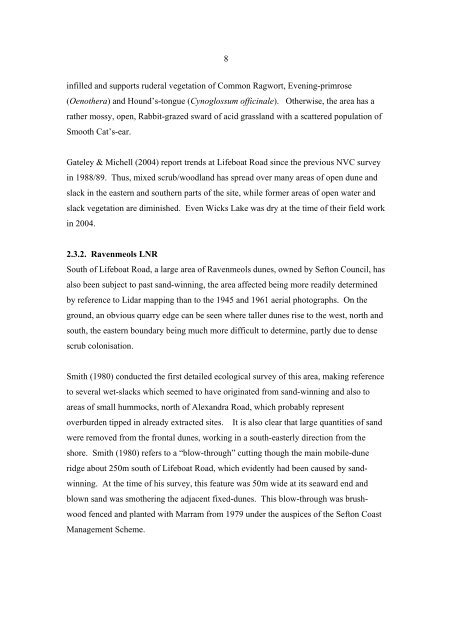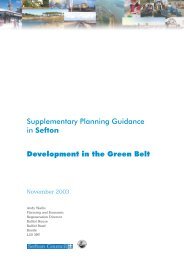The impact of sand extraction at Formby Point ... - Sefton Council
The impact of sand extraction at Formby Point ... - Sefton Council
The impact of sand extraction at Formby Point ... - Sefton Council
Create successful ePaper yourself
Turn your PDF publications into a flip-book with our unique Google optimized e-Paper software.
8<br />
infilled and supports ruderal veget<strong>at</strong>ion <strong>of</strong> Common Ragwort, Evening-primrose<br />
(Oenothera) and Hound’s-tongue (Cynoglossum <strong>of</strong>ficinale). Otherwise, the area has a<br />
r<strong>at</strong>her mossy, open, Rabbit-grazed sward <strong>of</strong> acid grassland with a sc<strong>at</strong>tered popul<strong>at</strong>ion <strong>of</strong><br />
Smooth C<strong>at</strong>’s-ear.<br />
G<strong>at</strong>eley & Michell (2004) report trends <strong>at</strong> Lifebo<strong>at</strong> Road since the previous NVC survey<br />
in 1988/89. Thus, mixed scrub/woodland has spread over many areas <strong>of</strong> open dune and<br />
slack in the eastern and southern parts <strong>of</strong> the site, while former areas <strong>of</strong> open w<strong>at</strong>er and<br />
slack veget<strong>at</strong>ion are diminished. Even Wicks Lake was dry <strong>at</strong> the time <strong>of</strong> their field work<br />
in 2004.<br />
2.3.2. Ravenmeols LNR<br />
South <strong>of</strong> Lifebo<strong>at</strong> Road, a large area <strong>of</strong> Ravenmeols dunes, owned by <strong>Sefton</strong> <strong>Council</strong>, has<br />
also been subject to past <strong>sand</strong>-winning, the area affected being more readily determined<br />
by reference to Lidar mapping than to the 1945 and 1961 aerial photographs. On the<br />
ground, an obvious quarry edge can be seen where taller dunes rise to the west, north and<br />
south, the eastern boundary being much more difficult to determine, partly due to dense<br />
scrub colonis<strong>at</strong>ion.<br />
Smith (1980) conducted the first detailed ecological survey <strong>of</strong> this area, making reference<br />
to several wet-slacks which seemed to have origin<strong>at</strong>ed from <strong>sand</strong>-winning and also to<br />
areas <strong>of</strong> small hummocks, north <strong>of</strong> Alexandra Road, which probably represent<br />
overburden tipped in already extracted sites. It is also clear th<strong>at</strong> large quantities <strong>of</strong> <strong>sand</strong><br />
were removed from the frontal dunes, working in a south-easterly direction from the<br />
shore. Smith (1980) refers to a “blow-through” cutting though the main mobile-dune<br />
ridge about 250m south <strong>of</strong> Lifebo<strong>at</strong> Road, which evidently had been caused by <strong>sand</strong>winning.<br />
At the time <strong>of</strong> his survey, this fe<strong>at</strong>ure was 50m wide <strong>at</strong> its seaward end and<br />
blown <strong>sand</strong> was smothering the adjacent fixed-dunes. This blow-through was brushwood<br />
fenced and planted with Marram from 1979 under the auspices <strong>of</strong> the <strong>Sefton</strong> Coast<br />
Management Scheme.















